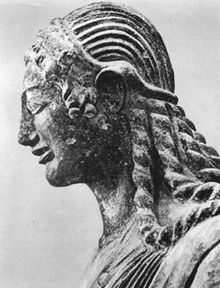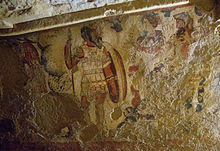Śuri
[2][5][6][7] Śuri was essentially a chthonic solar deity:[b] the volcanic fire god of light and darkness, lord of the sun and the underworld, with powers over health and plague as well.
[a] Because of his multiple attributes, the Etruscan fire god Śuri bore many epithets,[3][5] among them infernal theonyms – consistently associated with kingship over the Manes (underworld deities), infernal and volcanic attributes, fire, lightning, wolves and goats – like Manth (𐌈𐌍𐌀𐌌, Manθ, Latinized as Mantus),[10][3][5][c] Vetis (𐌔𐌉𐌕𐌄𐌅, also spelt 𐌔𐌉𐌅𐌉𐌄𐌅, Veivis, variously Latinized as Vēdius, Vēdiovis, Vēiovis or Vēive),[16][5] Calu (𐌖𐌋𐌀𐌂),[17][18][5] lit.
'dark' or 'darkness' or 'underworld',[19][20][b] and – by interpretatio graeca – the equivalent[21][22] foreignism Aita (𐌀𐌕𐌉𐌀, also spelt 𐌀𐌕𐌉𐌄, Eita),[23][24][25][3][5] from Epic Greek: Ἄϊδης, romanized: Áïdēs, lit.
[25][3] The center of his cult was Mount Soracte,[42][23][18][43][3][6][7] a sacred mountain located north of Rome, isolated in the middle of the countryside, in an area characterized by deep karst cavities and secondary volcanic phenomena; these phenomena were associated in antiquity with underworld deities,[26] whom the area was hence sacred to, such as the Roman Dīs Pater, syncretised with Śuri (Latin: Soranus).
[3][6][7] Furthermore, his theonym Manth (Latin: Mantus) is the eponymous of Mantua (Etruscan: Manthva, Italian: Mantova),[27][44][10][5] birthplace of Virgil, who also mentioned the volcanic god in the Aeneid.
The shepherds gave chase and ran to a cave – into Mount Soracte – from which such suffocating fumes emanated that those who pursued fell dead.
[53][32] Initially, some researchers supposed that the first lobe, where the gods of the lights and heavens are listed, could represent him, whereas the second an hypothetical partner named Tiur.
[37] Even outside his cult centers, Śuri is mentioned in multiple archaeological sites and artifacts, e.g. the bilingual Phoenician–Etruscan Pyrgi Tablets,[3][2][5][58] the Lead Plaque of Magliano,[17] and the Tabula Capuana.
[59][60] His mentions and depictions also reflect his multiple attributes and epithets, for example his solar theonyms in Pyrgi,[49][2] Caere,[61] and the aforementioned Liver of Piacenza.
[16][8][4] Frequently in associatiation with the aforementioned foreignism Apulu[g] (which does not appear on the Liver of Piacenza), equivalent to his native theonyms Rath,[29][61][d] Usil[32][f] and Vetis,[16][5] he is often depicted in art with a crown and laurel branches.
[63][64] His iconic depiction features the sun god rising out of the sea, with a fireball in either outstretched hand, on an engraved Etruscan bronze mirror in late Archaic style, formerly on the Roman antiquities market.
[66][67] The god – also known as Manth, king of the Manes[c] – also acts as psychopomp: he guides the souls of the deceased into the underworld, getting occasionally nicknamed Charun (Etruscan: Υ𐌛𐌀𐌙, romanized: Kʰaru, from Greek Charon)[68][44][69] and associated with the feminine counterpart Vanth.
[27] As such, he is often depicted on Etruscan coffins as a black-bearded animalistic man or satyr, with pale skin (symbolizing the decay of death),[70] pointed ears,[j] and enormous wings,[73][74][75] wearing a tunic and sometimes a crown or a cap, usually wielding a sledgehammer or a sword.
'dark' or 'darkness' or 'underworld'),[b] is equally identified by his wolf attributes, such as a wolf-like appearance or a wolf-skin cap;[77] and although the equivalent grecism Aita (lit.
'Hades' or 'underworld') is very rarely depicted, he may appear enthroned and sometimes wears a wolf-skin cap, borrowing a key attribute from earlier Calu.
[92] Varro, however, lists Summanus among gods he considers of Sabine origin, to whom king Titus Tatius dedicated altars (arae) in consequence of a votum.
[98][99][95][100] Cicero recounts that the clay statue of the god which stood on the roof of the Temple of Jupiter Optimus Maximus was struck by a lightning bolt: its head was nowhere to be seen.
[105] Mount Summano – located in the Alps near Vicenza, Veneto – is traditionally considered a site of the cults of Pluto, Summanus, and the Manes.
[109][115] Rudolf Simek notes that jötnar – frost and fire giants – are usually described as living to the east in Old Norse sources, yet Surtr is described as being from the south.
[116] These and other apparent coincidences[117] inspired the hypothesis that Surtr's mythic south could be identified in Śuri's Etruscan Italy,[107] but, despite the archaeological findings confirm ancient exchanges among the Tyrrhenians and the Proto-Germanic peoples,[p] systematic studies of comparative mythology and linguistics, as well as additional archaeological surveys, may still be needed to confirm deeper connections.







